
Newcastle Commercials e-bog
25,00 DKK
(inkl. moms 31,25 DKK)
The planning for the raising of what was to become 16th (Service) Battalion, Northumberland Fusiliers, started within two days of the outbreak of the war. The initial efforts took on a more professional look within a month, when the Newcastle Chambers of Commerce set about raising money and aiming to raise several battalions in response to Lord Kitchener's call for men. The outcome was a Pals b...
E-bog
25,00 DKK
Forlag
Pen & Sword Military
Udgivet
8 december 2021
Genrer
1DBKEYN
Sprog
English
Format
epub
Beskyttelse
LCP
ISBN
9781526735324
The planning for the raising of what was to become 16th (Service) Battalion, Northumberland Fusiliers, started within two days of the outbreak of the war. The initial efforts took on a more professional look within a month, when the Newcastle Chambers of Commerce set about raising money and aiming to raise several battalions in response to Lord Kitchener's call for men. The outcome was a Pals battalion, the 1st Newcastle Commercials. Arriving in France at the end of 1915, the battalion, like so many others of its type, had its first experience of a major action on the Somme on 1st July 1916, in its case in the forlorn attempt to capture the German front line village of Thiepval. The outcome is well known; a disaster that ravaged the battalion's ranks. However, the battalion was reinforced, reorganized, and took its part in actions at Ovillers and along the Ancre as the battle grinder on over the next four and a half months. In 1917 it was involved in the advance on the Hindenburg Line and was then transferred to the North Sea coast, with the intention of taking part in the daring plan to launch a major amphibious landing behind the German lines in the summer. This was thwarted by a masterly pre-emptive German counter stroke. By the end of the year the battalion was engaged in operations in the northern part of the Salient after the Battle of Third Ypres (Passchendaele) had formally ended. In early February 1918 the battalion was disbanded as part of a general reorganization of the BEF, which saw divisions losing three of their twelve infantry battalions. In outline it is a common story; but, as for all the Pals battalions, its unusual origins and its very close connection to a local area, in this case Newcastle, provides an enduring fascination for today's generation. Ian Johnson has worked extraordinarily hard to gather documents from members of the battalion - letters, diaries, and recollections - as well as numerous photographs. He has prepared extensive appendices on its membership and its casualties. The outcome is a fitting tribute to these young men from Newcastle men of a century ago who, for whatever motive, answered their country's call, all too many of whom paid for it with their lives or their health.
 Dansk
Dansk

